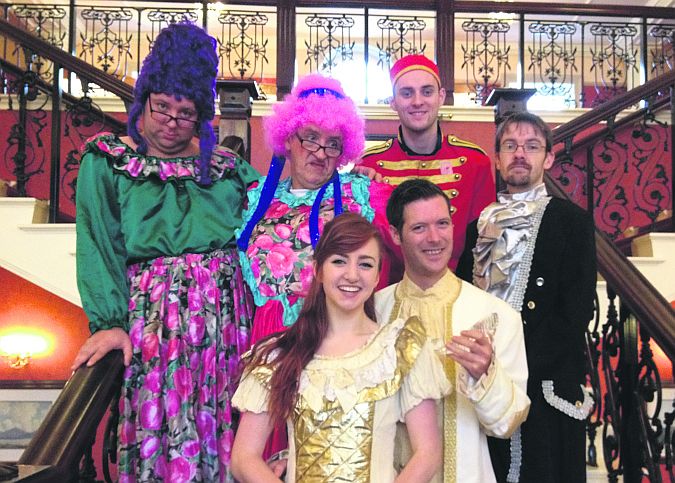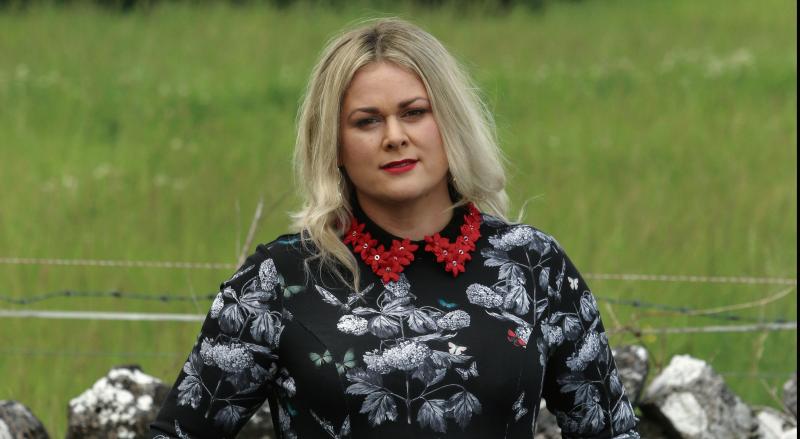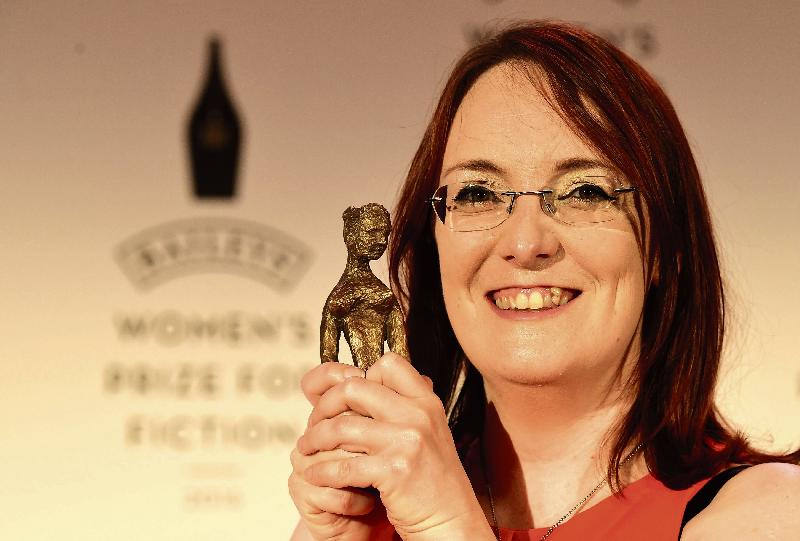Books
Donald a trump card for Cinderella panto

Arts Week with Judy Murphy
When it comes to panto, there is nothing like a dame, and when it comes to dames, there is nobody like Peter Kennedy.
Belfast-born Peter is the man responsible for giving a new spin to this year’s offering from the Renmore Pantomime Society, which runs at the Town Hall Theatre from next Monday, December 29 to Sunday, January 11.
This production of Cinderella will retain all the important elements of the much-loved fairytale, but there will be some interesting contemporary twists too, says Peter. The colourful cast will include no less a character than King Donald Trumpet, who is seeking a bride for his son, Prince Charming.
The inspiration for King Trumpet came after American billionaire Donald Trump hit the headlines this year when he purchased Doonbeg Golf Club and Hotel in West Clare.
That gave Peter an opportunity to mix in some golfing situations to Cinderella that haven’t been seen in panto for a long time, he explains.
“I always try to think of something off the track from the normal story to give it a modern twist.”
When it comes to writing pantos, it’s all about balance, adds Peter, who has years of experience in this area. Before moving to Galway, the Abbeyknockmoy resident helped stage 15 pantos in his native Belfast.
In his work with the Renmore Society, he always tries to remain faithful to the core of the story being staged, because he is mindful that the group is playing to a new generation every year.
But it’s also important to alter a setting or introduce a new character or two in order to keep things fresh for parents, he explains.
“If you don’t get the parents, you won’t get the children.”
Peter was reared in the world of pantomime and musicals in Belfast, where his father was a member of the Ulster Operatic Company.
“I love the fact that panto is generally an introduction to theatre for children,” he says. “As somebody who has been involved in drama my whole life, I know how beneficial it is for them.
“And of course, I am basically a child myself,” he adds of his enduring involvement with the art form.
For more, read this week’s Connacht Tribune.
Connacht Tribune
Galway poet’s new chapter as debut novel hits the shops

“I hated school so much I thought if I could be a teacher, I could make it a bit better,” says novelist and poet Elaine Feeney about her day-job as an English and History teacher at St Jarlath’s College in Tuam.
The Athenry woman certainly has made it livelier and more relevant. Her students who were studying Hamlet for this year’s Leaving Cert departed from the text to give the troubled prince psychotherapy sessions, with different boys taking on the roles of Hamlet and the therapist as they explored the plot. Elaine laughs as she recalls how they got totally caught up in it. There’s always an entry point to good writing, she says, adding that she loves Shakespeare – in part because of the soap opera element to his drama.
“You can compare it to the latest episode of EastEnders”.
The Handmaid’s Tale by contemporary Canadian novelist Margaret Atwood is also on the curriculum. Her novel might seem more relevant to the boys, especially given its global success since being adapted for television. When Elaine learned that Atwood would be visiting Galway in early March this year for a Galway 2020 event, she asked the organisers if it would be possible for the class to meet her and discuss her work. That’s what happened and 25 young men in their school blazers spent three hours discussing the novel with Atwood.
Elaine lectures in Creative Writing at NUIG and has been involved in the university’s project archiving the stories of the survivors of Tuam’s Mother and Baby home. So, watching her students engage with a woman whose books deal with the misuse of power and oppression of women was a great moment.
It’s an example of how far she’ll go to give the students the best preparation for exams and for life. Elaine has a great relationship with them, something she’ll miss next year as she takes a career break to promote her own novel, As You Were, published by UK company Harvill Secker.
Read the full interview with Elaine Feeney in this week’s Connacht Tribune.
Connacht Tribune
New book unpicks the mysteries of Salthill

Salthill. It’s familiar to anyone who lives in Galway, whether as somewhere to go for a walk and ‘kick the wall’, or as a place to visit during sunny summer days for the beaches, the ice-creams and the funfair. But as a new book by retired teacher and broadcaster Paul McGinley shows, there’s much more to this seaside resort than meets the eye.
Salthill: A History, Part 1, tells how this once-rural hamlet on the outskirts of Galway developed into a seaside resort from the mid-1800s.
Paul who was reared in Salthill and is fascinated by history, had observed that while rural parts of Ireland have a rich folklore tradition, passed on from generation to generation, the same wasn’t true of Salthill.
He’d gone to school in the Bish where his teachers included the late Dónal Taheny, a well-known local historian who died in 2014 at the age of 95.
“He had a great sense of the local and a real pride in Salthill,” recalls Paul. Dónal used to stress the importance of local history and it was through him that Paul first began to notice that Salthill’s lore didn’t stretch back through the generations as it does in other places.
As he delved more deeply, that makes sense.
“People move to Salthill and they say ‘I’m a blow-in’, but in a way, everyone is. It just depends on for how long,” Paul notes as he gives examples of families who are well known locally. Very few go back more than a few generations.
Those who are well-established include the Stewarts of Stewart Construction, who can trace their paternal Salthill roots back to 1900 when James Stewart married Mary Ann Gill of Lower Salthill and two years later, set up the company that’s now so well-known. The Toft family of Tofts’ amusement were first recorded as having visited in 1883 – they were seasonal until 1941-2 when they settled permanently.
Another well-known family established roots in 1933 when Frank Hallinan arrived. He became head of a group known as the Castlerea Consortium which bought a field known as the Monks’ Field and sold plots and houses there. The only stipulation for buyers was that they couldn’t open a butcher shop, as Frank owned one, across from Seapoint in the days before it became a ballroom, Paul explains.
The Monks’ Field was so-called because it belonged to the Christian Brothers who owned the Salthill Industrial School – they farmed it, often causing annoyance to local farmers, whom they undercut on prices.
After the Finan family opened Seapoint Ballroom in 1949, Frank Hallinan launched the Oslo Hotel, which had 13 bedrooms and registered it with the Irish Tourist Board.
“Frank didn’t know then that Johnny Cash and June Carter would stay there,” says Paul referring to the legendary singers who toured Ireland in the early 1960s.
Another man to make a lasting impression was Tom O’Connor who arrived to Salthill from Moylough in 1942, having sold a farm and other business interests, to invest in the premises now known as O’Connors’ Famous Pub. The Finans, who owned the Bon Bon as well as Seapoint, settled when Martin Finan married local woman, Mary Ellen Glancy in 1907.
Paul traces all this history and more as he recalls his own youth. As someone who loved music, Salthill was heaven, mainly because of the Hangar, which opened in 1924 and ran for decades before being closed.
For more, read this week’s Connacht Tribune.
Get the Connacht Tribune Live app
The Connacht Tribune Live app is the home of everything that is happening in Galway City and county. It’s completely FREE and features all the latest news, sport and information on what’s on in your area. Click HERE to download it for iPhone and iPad from Apple’s App Store, or HERE to get the Android Version from Google Play.
Books
Gort’s Lisa lost for words

Gort author Lisa McInerney is in no danger of getting a swelled head after winning the UK’s most prestigious fiction award for woman authors for her debut novel, The Glorious Heresies.
A week after she won the £30,000 Bailey’s prize, beating five other authors including fellow Irish novelist, the Man Booker winner Anne Enright, she’s still bemused.
“I still haven’t got my head around it. Even looking at the long list, I’m thinking there were some amazing writers on it, so how did this happen?” says the author of this pacey, blackly comic novel set in Cork.
But, as she points out, “a lot of writers are probably their own biggest critics anyway” and that’s definitely true in her case.
McInerney, who was born in Gort in 1981, has been writing since she can remember and has, somewhere in her possession, a ‘book’ she wrote at the age of seven or eight.
“It was maybe six pages long, in a copybook,” she says adding that she used to read a lot and “a child’s imagination sees no barrier. If they can read stories, they don’t see why they can’t write them as well”.
That’s what she did, all through school and college – “all rubbish” – but helping to hone her skills.
“It’s a compulsion, something you can’t help but do,” she says of writing, adding that even when it comes to trying to make sense of events in her own life, she puts pen to paper.
“I see the world through text and prose and words. Other people might see it through maths or in pictures.”
Lisa’s world was an interesting one from the get-go. Born to 19-year-old single mother in Gort in 1981, she was adopted by her grandparents after birth.
People wonder if that was traumatic, she says, but it wasn’t one bit. At the time, children born to single parents were regarded by the State as illegitimate, a situation that wasn’t amended until 1987.
“From their point of view, they were worried it might affect my status in future,” she explains.
Lisa always knew the story of her birth and adoption and was fine with it.
“Kids are very adaptable if you tell them when they are young, as opposed to telling them when they are older. That’s when people have a harder time, when their views are set.”
Her mother subsequently met and married another man and Lisa has a half-sister. They all have a very good relationship, she says.
She loves Gort and still lives there, but when she finished her Leaving Cert at the age of 16 and was offered a place in UCC, she leaped at it.
“In South County Galway, I have a huge family I was very much the youngest and nobody ever listened to me,” she says with a laugh. So Cork, which she knew through her cousins in Carragaline, offered a chance to forge her own identity.
“I went down there at 17, the kind of age when you are learning who you are. Me and Cork got very intertwined at that stage. Even though Galway is home, I was always very happy in Cork.”
That kind of mixed emotion about the home place is very strong in Ireland, she says, adding that her husband, “who is from Cork feels very happy in Galway”.












